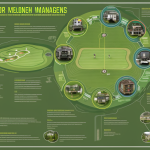Golf courses are often perceived as a luxury and a waste of resources, but they can also be a source of environmental sustainability. With the growing awareness of the impact of human activities on the environment, it is essential to redefine golf course sustainability and explore strategies for a greener future. This article will discuss some innovative approaches to make golf courses more sustainable, from water conservation to energy-efficient practices. We will also explore the role of technology and the importance of community engagement in promoting sustainable golf courses. Get ready to discover how golf courses can become a catalyst for environmental stewardship and a model for sustainable development.
Understanding Golf Course Sustainability
The Importance of Sustainable Golf Course Management
Environmental Impact of Golf Courses
Golf courses, while providing recreational benefits, also have a significant impact on the environment. These impacts can include the use of large amounts of water, pesticides, and fertilizers, which can lead to soil and water pollution. Additionally, golf courses often require the removal of native vegetation and the introduction of non-native species, which can negatively impact local ecosystems. Furthermore, the construction and maintenance of golf courses can result in habitat destruction and fragmentation, which can harm wildlife populations.
Economic and Social Benefits of Sustainable Golf Courses
Sustainable golf course management can provide numerous economic and social benefits. These benefits can include cost savings through the use of more efficient irrigation systems and reduced chemical usage, as well as increased revenue through attracting environmentally conscious golfers. Additionally, sustainable golf courses can help to improve the reputation of the golf course and the surrounding community, which can lead to increased property values and tourism. Furthermore, sustainable golf courses can provide habitat for wildlife, which can be a draw for ecotourism.
In conclusion, sustainable golf course management is important for both the environment and the economy. By implementing sustainable practices, golf courses can reduce their environmental impact while also benefiting from cost savings and increased revenue.
Key Concepts and Principles in Golf Course Sustainability
Integrated Pest Management
Integrated Pest Management (IPM) is a sustainable approach to managing pests on golf courses. IPM focuses on the use of preventive measures to reduce pest populations, rather than relying solely on chemical pesticides. This approach involves monitoring pest populations, identifying pest entry points, and implementing practices such as introducing natural predators and adjusting cultural practices to minimize pest habitats. By adopting IPM, golf courses can reduce their reliance on chemical pesticides, which can harm the environment and potentially harm human health.
Water Conservation and Quality
Water conservation and quality are critical components of golf course sustainability. Golf courses often require significant amounts of water to maintain their greens, fairways, and other features. However, many golf courses are located in areas with limited water resources or are vulnerable to water scarcity due to climate change. To address these challenges, golf courses can implement water-saving technologies, such as irrigation systems with moisture sensors and recycled water systems. They can also adopt best management practices for water quality, such as minimizing the use of fertilizers and pesticides that can contaminate groundwater and surface water.
Energy Efficiency and Renewable Energy
Energy efficiency and renewable energy are essential for reducing the environmental impact of golf courses. Golf courses can reduce their energy consumption by implementing energy-efficient lighting, heating, and cooling systems. They can also install renewable energy systems, such as solar panels or wind turbines, to generate a portion of their energy needs. By adopting these strategies, golf courses can reduce their carbon footprint and save money on energy costs.
Waste Reduction and Recycling
Waste reduction and recycling are key components of golf course sustainability. Golf courses generate significant amounts of waste, including grass clippings, leaves, and branches. By implementing waste reduction strategies, such as composting and mulching, golf courses can reduce the amount of waste they generate. They can also adopt recycling programs for materials such as cardboard, plastic, and metal. These strategies can help golf courses reduce their environmental impact and save money on waste disposal costs.
Biodiversity and Habitat Preservation
Biodiversity and habitat preservation are critical for the long-term sustainability of golf courses. Golf courses can impact local ecosystems by altering habitats, removing native vegetation, and introducing non-native species. To promote biodiversity and habitat preservation, golf courses can adopt practices such as preserving natural habitats, restoring native vegetation, and creating habitats for local wildlife. By supporting biodiversity and habitat preservation, golf courses can enhance the environmental value of their courses and promote a sustainable future for golf.
Assessing the Current State of Golf Course Sustainability
Challenges and Opportunities in Golf Course Sustainability
Perception and Prioritization of Sustainability in the Golf Industry
The golf industry has traditionally been perceived as a high-end, environmentally insensitive sport, with a focus on aesthetics and playing conditions. However, there is a growing recognition that golf courses can be managed in a more sustainable manner. Many golf course owners and operators are beginning to see the value in adopting sustainable practices, not only for environmental reasons but also for financial and reputational benefits.
Regulatory Frameworks and Certification Programs
While there are some regulations in place to protect the environment on golf courses, such as those related to water and chemical use, there is no overarching regulatory framework that specifically addresses sustainability in golf. Certification programs, such as the Audubon Cooperative Sanctuary Program and the GEO Foundation’s OnCourse Program, have been established to help golf courses implement sustainable practices and receive recognition for their efforts. However, these programs are voluntary and only a small percentage of golf courses have pursued certification.
Golf Course Design and Construction Practices
The design and construction of golf courses can have a significant impact on their environmental footprint. Traditional golf course design often involves clearing large areas of land, redistributing soil, and using intensive irrigation systems, all of which can lead to habitat destruction, water pollution, and other environmental issues. However, there are alternative design approaches that prioritize sustainability, such as restoring natural habitats, preserving existing vegetation, and using drought-tolerant plants. Some golf course architects and developers are embracing these approaches, but they are still the exception rather than the norm.
In conclusion, while there are challenges and opportunities in golf course sustainability, the industry is slowly beginning to recognize the importance of adopting more environmentally friendly practices. However, further efforts are needed to encourage and incentivize sustainable practices, both through regulatory frameworks and certification programs, as well as through changes in design and construction practices.
Implementing Sustainable Practices on Golf Courses
Strategies for Sustainable Golf Course Management
Turfgrass Selection and Maintenance
Selecting the right turfgrass species is crucial for sustainable golf course management. Factors such as climate, soil type, and traffic should be considered when choosing turfgrass varieties. Proper turfgrass maintenance involves mowing at the appropriate height, using proper irrigation techniques, and applying the right amount of fertilizer. Additionally, implementing integrated pest management practices can help reduce the use of chemicals on the golf course.
Irrigation and Water Management
Efficient irrigation systems and water management practices are essential for sustainable golf course management. Golf courses typically use a significant amount of water, so it is important to identify areas that require more water and those that can be conserved. Implementing drought-resistant turfgrass, using efficient irrigation systems, and collecting and recycling water can help reduce water usage on the golf course.
Energy-Efficient Equipment and Facilities
Energy-efficient equipment and facilities can help reduce the golf course’s carbon footprint and lower operating costs. Implementing energy-efficient lighting, using hybrid or electric golf carts, and installing solar panels can significantly reduce energy consumption. Additionally, conducting regular maintenance on equipment can help improve energy efficiency and extend the lifespan of machinery.
Waste Reduction and Recycling Programs
Waste reduction and recycling programs are crucial for sustainable golf course management. Reducing waste by implementing recycling programs for materials such as cardboard, paper, and plastic can help minimize landfill waste. Additionally, composting organic waste such as grass clippings and food waste can help create a nutrient-rich soil amendment for the golf course.
Biodiversity and Habitat Restoration
Restoring habitats and promoting biodiversity can help create a more sustainable golf course. Implementing native plant species and creating wildlife habitats such as bird boxes and bat houses can help promote biodiversity. Additionally, reducing the use of chemicals on the golf course can help support local ecosystems and promote a healthier environment for wildlife.
Collaboration and Education for Sustainable Golf Course Management
Partnerships with Local Communities and Environmental Organizations
Collaborating with local communities and environmental organizations is crucial for fostering sustainable golf course management. By working together, golf courses can benefit from the knowledge and resources of these organizations while also contributing to their local environmental initiatives.
Some potential partnership opportunities include:
- Collaborating with environmental organizations to develop habitat restoration projects that improve the biodiversity of the surrounding ecosystems.
- Partnering with local schools to provide educational programs on environmental stewardship and sustainability, both on and off the golf course.
- Engaging with community groups to promote sustainable practices and raise awareness about the environmental benefits of golf courses.
Staff Training and Education Programs
To ensure that golf courses are managed sustainably, it is essential to provide staff with the necessary education and training. This can include:
- Providing regular training sessions on sustainable practices, such as integrated pest management and efficient irrigation techniques.
- Offering professional development opportunities for staff to learn about the latest sustainable technologies and techniques.
- Encouraging staff to participate in industry conferences and workshops focused on sustainability in golf course management.
Engaging Golfers in Sustainable Practices
Golfers can also play a significant role in promoting sustainable practices on golf courses. By engaging golfers in sustainable practices, golf courses can create a culture of environmental stewardship and encourage the adoption of sustainable behaviors both on and off the course.
Some strategies for engaging golfers in sustainable practices include:
- Providing educational materials and signage throughout the course to educate golfers about the importance of sustainable practices and how they can contribute to a greener future.
- Encouraging golfers to participate in sustainable practices, such as using electric or hybrid golf carts, properly disposing of waste, and reducing water usage.
- Recognizing and rewarding golfers who demonstrate sustainable behaviors, such as using reusable water bottles or properly maintaining the course’s natural habitats.
Monitoring and Evaluating Golf Course Sustainability
Metrics and Indicators for Golf Course Sustainability
Measuring the success of sustainability initiatives on golf courses is crucial for evaluating the effectiveness of these programs and making informed decisions for future improvements. The use of metrics and indicators provides a comprehensive and systematic approach to evaluating the sustainability of golf courses. In this section, we will discuss the different metrics and indicators that can be used to measure the environmental, economic, and social aspects of golf course sustainability.
Environmental Impact Assessment
The environmental impact assessment of golf courses is an essential aspect of sustainability evaluation. It involves measuring the ecological footprint of the golf course, including the amount of land used, water consumption, energy consumption, greenhouse gas emissions, and waste generation. The following indicators can be used to assess the environmental impact of golf courses:
- Land use intensity: Measures the amount of land used by the golf course relative to its size.
- Water consumption: Measures the amount of water used for irrigation, maintenance, and other purposes.
- Energy consumption: Measures the amount of energy used for golf course operations, including the use of machinery and lighting.
- Greenhouse gas emissions: Measures the amount of carbon dioxide and other greenhouse gases emitted by the golf course.
- Waste generation: Measures the amount of waste generated by the golf course, including solid waste, wastewater, and chemical waste.
Economic and Social Benefits Measurement
Evaluating the economic and social benefits of golf courses is also essential for determining their sustainability. This includes measuring the economic impact of the golf course on the local community, such as job creation, tax revenue, and tourism. Social benefits, such as community engagement, access to green spaces, and health and wellness, can also be measured. The following indicators can be used to assess the economic and social benefits of golf courses:
- Economic impact: Measures the direct and indirect economic benefits generated by the golf course, such as employment, tax revenue, and tourism.
- Community engagement: Measures the level of community involvement and participation in golf course activities.
- Access to green spaces: Measures the availability of green spaces for the community to enjoy.
- Health and wellness: Measures the impact of golf courses on the physical and mental health of the community.
Stakeholder Engagement and Feedback
Stakeholder engagement and feedback are crucial for ensuring that sustainability initiatives on golf courses are effective and well-received by all parties involved. This includes engaging with golf course staff, community members, and other stakeholders to gather feedback on sustainability initiatives and identify areas for improvement. The following indicators can be used to assess stakeholder engagement and feedback:
- Staff engagement: Measures the level of engagement and participation of golf course staff in sustainability initiatives.
- Community engagement: Measures the level of engagement and participation of the community in sustainability initiatives.
- Feedback and suggestions: Measures the feedback and suggestions received from stakeholders on sustainability initiatives.
By using these metrics and indicators, golf courses can evaluate their sustainability efforts and make informed decisions for future improvements.
Continuous Improvement and Adaptation to Climate Change
Climate Change Impact Assessment
To ensure golf courses remain sustainable, it is crucial to understand the impact of climate change on their ecological, social, and economic systems. Climate change impact assessments should evaluate the following aspects:
- Temperature increase: Analyze the potential effects of rising temperatures on turfgrass growth, pest and disease management, and water requirements.
- Changes in precipitation patterns: Investigate how variations in rainfall may affect irrigation needs, runoff, and soil moisture levels.
- Extreme weather events: Assess the vulnerability of golf courses to extreme weather events, such as droughts, floods, and storms, and identify appropriate risk reduction strategies.
- Shifts in plant and animal species: Identify potential changes in native plant and wildlife populations and develop strategies to support biodiversity.
Adaptation Strategies for Golf Course Management
To address the challenges posed by climate change, golf course managers can implement the following adaptation strategies:
- Drought-resistant turfgrass: Select turfgrass species and cultivars that are more resistant to drought, reducing the need for water during dry periods.
- Water conservation measures: Implement efficient irrigation systems, use recycled water, and practice integrated pest management to minimize water consumption.
- Flood and erosion control: Design golf courses with appropriate grading and drainage systems to reduce the risk of flooding and soil erosion.
- Green infrastructure: Incorporate features such as bioswales, rain gardens, and permeable surfaces to manage stormwater runoff and improve soil health.
- Energy-efficient facilities: Upgrade golf course buildings and equipment to energy-efficient standards, reducing greenhouse gas emissions and energy costs.
Incorporating Climate Change Education and Awareness
To ensure the long-term sustainability of golf courses, it is essential to educate and raise awareness among golf course managers, staff, and players about the impacts of climate change and the importance of adaptation strategies. This can be achieved through:
- Training programs: Develop educational workshops and training sessions to teach golf course managers and staff about climate change adaptation and mitigation techniques.
- Resource materials: Create comprehensive guides, manuals, and fact sheets that provide practical information on climate change adaptation strategies for golf courses.
- Outreach and communication: Engage with golf course communities, players, and other stakeholders through workshops, seminars, and social media platforms to promote climate change awareness and encourage the adoption of sustainable practices.
- Partnerships and collaborations: Establish partnerships with academic institutions, research organizations, and government agencies to access the latest knowledge and technology in climate change adaptation and to foster knowledge-sharing among industry stakeholders.
Advancing Golf Course Sustainability: Research and Innovation
Identifying Research Priorities and Opportunities
Technology and Innovation in Sustainable Golf Course Management
One area of research priorities and opportunities is the development of new technologies and innovative practices to enhance sustainable golf course management. This includes the exploration of precision irrigation systems, efficient energy systems, and integrated pest management strategies. Additionally, research could focus on the development of new turfgrass varieties that are more tolerant to environmental stresses and require less water and fertilizer.
Best Practices and Case Studies
Another priority is to identify and disseminate best practices and case studies of sustainable golf course management. This involves documenting and sharing successful examples of how golf courses have implemented sustainable practices, such as water conservation, waste reduction, and habitat restoration. This information can serve as a valuable resource for golf course managers and decision-makers looking to adopt sustainable practices.
Policy and Regulatory Frameworks
Research is also needed to evaluate the effectiveness of existing policies and regulatory frameworks related to golf course sustainability. This includes examining the impact of government incentives and regulations on the adoption of sustainable practices by golf courses. Additionally, research could explore the role of voluntary certification programs, such as Audubon International’s Cooperative Sanctuary Program, in promoting sustainable golf course management.
Overall, identifying research priorities and opportunities is critical to advancing golf course sustainability and ensuring a greener future for the industry. By focusing on technology and innovation, best practices and case studies, and policy and regulatory frameworks, researchers and industry stakeholders can work together to promote sustainable golf course management practices and achieve a more sustainable future for the sport.
Collaboration and Knowledge Sharing in the Golf Industry
Collaboration and knowledge sharing within the golf industry are crucial components for advancing sustainability practices on golf courses. By working together, golf course managers, superintendents, researchers, and industry professionals can pool their collective knowledge and resources to develop innovative solutions that address the unique challenges faced by the golf industry.
Industry Networks and Conferences
Industry networks and conferences provide valuable platforms for collaboration and knowledge sharing. These events bring together golf course managers, superintendents, and industry professionals from around the world to discuss the latest trends, research, and best practices in golf course sustainability. Attendees have the opportunity to learn from experts, share their own experiences, and collaborate on projects that promote sustainability on golf courses.
Some examples of industry networks and conferences include:
- The Golf Course Superintendents Association of America (GCSAA)
- The European Golf Course Owners Association (EGCOA)
- The Asia Pacific Golf Course Superintendents Association (APGCSA)
- The Golf Industry Conference
- The Golf Course Builders Association of America (GCBAA)
Open Access Databases and Research Platforms
Open access databases and research platforms are essential resources for sharing research and data related to golf course sustainability. These platforms provide access to a wealth of information on topics such as turfgrass management, water conservation, and integrated pest management. By sharing this information, researchers and industry professionals can work together to develop more sustainable practices for golf courses.
Some examples of open access databases and research platforms include:
- The Turfgrass Information Center
- The USGA Green Section Record
- The Golf Course Superintendents Association of America (GCSAA) Research Library
- The International Journal of Golf Science
- The Golf Course Management Online Journal
Through collaboration and knowledge sharing, the golf industry can continue to make strides in advancing sustainability practices on golf courses. By working together, industry professionals can share their experiences, learn from experts, and develop innovative solutions that promote a greener future for golf.
Preparing for the Future: Young Professionals and Sustainable Golf Course Management
Educational Programs and Career Development
The golf industry is facing a critical shortage of skilled professionals who are knowledgeable about sustainable golf course management practices. To address this issue, educational programs focused on sustainable golf course management should be developed and promoted. These programs should provide students with the necessary knowledge and skills to implement sustainable practices on golf courses, such as integrated pest management, water conservation, and waste reduction. Additionally, these programs should emphasize the importance of sustainability in the golf industry and highlight the potential career opportunities in this field.
Mentorship and Networking Opportunities
Mentorship and networking opportunities are essential for young professionals in the golf industry to learn from experienced professionals and build their professional networks. Mentorship programs can provide young professionals with guidance and support as they navigate their careers in sustainable golf course management. Networking events, such as conferences and workshops, can also provide young professionals with opportunities to connect with industry leaders and learn about the latest trends and innovations in sustainable golf course management.
Encouraging Innovation and Entrepreneurship in Sustainable Golf Course Management
Young professionals are often more open to new ideas and innovative approaches to sustainable golf course management. Therefore, it is essential to encourage innovation and entrepreneurship among young professionals in the golf industry. This can be achieved by providing them with opportunities to participate in research projects, innovation challenges, and entrepreneurship programs. Additionally, funding and support should be provided to young professionals who want to develop and implement innovative sustainable golf course management practices. By encouraging innovation and entrepreneurship, young professionals can contribute to the development of new sustainable practices that can help the golf industry become more environmentally friendly and socially responsible.
FAQs
1. What is meant by “sustainable golf courses”?
Sustainable golf courses refer to the practice of designing, constructing, and maintaining golf courses in a way that minimizes environmental impact and preserves natural resources for future generations. This includes implementing environmentally friendly practices such as using native plants, conserving water, reducing chemical use, and preserving wildlife habitats.
2. Why is sustainability important for golf courses?
Golf courses are significant users of natural resources, including water, energy, and land. They also generate waste and emit greenhouse gases. By adopting sustainable practices, golf courses can reduce their environmental footprint, save money, and enhance their reputation as responsible stewards of the environment.
3. What are some sustainable practices that can be implemented on golf courses?
There are many sustainable practices that can be implemented on golf courses, including:
* Using native plants and grasses that are adapted to local climate and soil conditions, reducing the need for irrigation and fertilizers.
* Implementing integrated pest management (IPM) strategies to reduce the use of chemical pesticides and herbicides.
* Using recycled or reclaimed water for irrigation, reducing the demand for potable water.
* Installing solar panels or wind turbines to generate renewable energy.
* Creating habitats for wildlife, such as bird boxes, bat houses, and bee hotels.
* Using sustainable landscaping practices, such as composting and using natural mulch.
4. How can golf courses reduce their carbon footprint?
Golf courses can reduce their carbon footprint by implementing sustainable practices such as using renewable energy sources, reducing energy use through efficient lighting and equipment, and implementing carbon offset programs. They can also reduce their transportation emissions by using electric or hybrid golf carts and promoting carpooling or public transportation for staff and visitors.
5. What is the role of technology in making golf courses more sustainable?
Technology can play a key role in making golf courses more sustainable. For example, using precision irrigation systems can reduce water use, while solar-powered golf carts can reduce energy use. There are also software programs available that can help golf courses track their energy and water use, identify areas for improvement, and measure their progress towards sustainability goals.
6. What are the benefits of sustainable golf courses for the community?
Sustainable golf courses can provide numerous benefits for the community, including:
* Preserving natural habitats and wildlife, which can enhance the quality of life for local residents.
* Providing recreational opportunities for the community, such as walking trails and outdoor exercise areas.
* Creating jobs and economic opportunities through sustainable tourism and ecotourism.
* Educating the public about the importance of environmental stewardship and sustainability.
7. What are some challenges to implementing sustainable practices on golf courses?
Implementing sustainable practices on golf courses can be challenging, as it often requires a significant investment of time and money. Golf courses may also face resistance from staff or members who are unfamiliar with or resistant to sustainable practices. Additionally, there may be regulatory or logistical barriers to implementing certain sustainable practices, such as obtaining permits or accessing funding.
8. How can golf courses engage with their communities to promote sustainability?
Golf courses can engage with their communities to promote sustainability by:
* Hosting educational events and workshops on sustainable practices and environmental stewardship.
* Partnering with local schools and community organizations to promote sustainability education and outreach.
* Providing opportunities for the community to participate in sustainable activities, such as volunteer days or eco-tourism programs.
* Sharing their sustainability achievements and progress with the community through newsletters, social media, and other communications channels.
9. What are some resources available to help golf courses become more sustainable?
There are many resources available to help golf courses become more sustainable, including:
* The Golf








